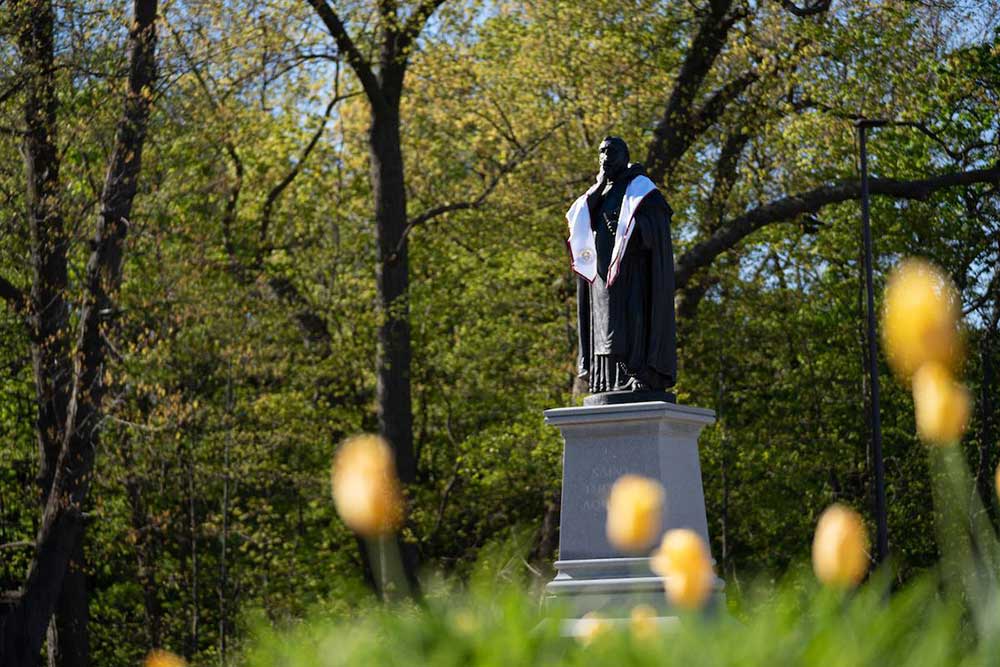Campus Ministry at Aquinas College

Saint Thomas Aquinas
Thomas Aquinas (1225 - 1274; of Aquino, Italy) was an Italian philosopher and theologian known as the Angelic Doctor. Born of a wealthy family at Rocca Secca, near Naples, in Italy, he disappointed his family by joining a poor order of preachers (1244) that followed the Rule of Dominic and were therefore known as Dominicans. In 1245, he began to study in Paris, France with Albertus Magnus whose favorite pupil he became.
In 1248, he accompanied Albert to Cologne, Germany. From there, Thomas returned to Paris (1252) where he became known as a great teacher and theologian. He spent some time in Rome as a papal advisor, returned to Paris to teach for a period and then returned to Naples to found a house of studies (1272). In 1274, on the way to a church council at Lyons, France, he took sick and died at the age of 49.
His works show him to be a brilliant lecturer, a clear thinker and an Aristotelian. In an age which was uncomfortable with the notion that the universe could be known apart from revelation, he pioneered the use of the Greek philosophy that featured the power of reason to demonstrate that God and his universe could be understood by reason guided by faith. His large girth and slow, deliberate style earned him the nickname "The Dumb Ox!"
He was the composer of several memorable religious hymns - O Salutaris Hostia and Pange Lingua being the most familiar to modern worshippers. His extensive writings explored the relationship between the mind of man and the mind of God and his synthesis of knowledge relating to this joining of intellect and religious belief, entitled The Summa Theologica (1267-1273), earned him a lasting reputation among scholars and religious alike. An earlier work, Summa Contra Gentiles (1258 - 1260), is written in a style that attempts to establish the truth of Christian religious belief in arguments addressed to an intelligent, but non-Christian reader.
His proofs for the existence of God, apart from faith and revelation, utilizing the power of reason are considered flawed by some 20th century historians of philosophy (Bertrand Russell, for example) because, he argues, Thomas proved what he already believed to be true. Therefore, according to Russell, his work should be viewed as an artful, concise argument, but not a decisive proof.
In spite of this reservation, Russell acknowledges Thomas's contributions to the intellectual movement called Scholasticism, which succeeded in liberating scholarship from the provincial shackles that uninformed religious censorship often created for it. Thomas also continued in the spirit of Albert the Great to lay a foundation of legitimacy for the Christian study of natural phenomena that allowed Christian Europe to proceed to the initial stages of the scientific revolution. Pope Leo XIII declared Scholasticism in 1879, in the encyclical Aeterni Patris, to be the official Roman Catholic philosophy.
Aquinas' five proofs for the existence of God might be summarized as follows:
- The unmoved Mover: Whatever is moved, is moved by something, and since an endless regress is not possible, a Prime Mover is required.
- The first Cause: Every result has a cause and since an endless regress is impossible, there must be a First Cause.
- The ultimate Necessity: Essentially a repeat of Reason (2.), there must be a source for all consequences which follow.
- Perfect Source: All perfection in the world requires, as its source, an Ultimate Perfection.
- Purpose: Even lifeless things have a purpose which must be defined by something outside themselves, since only living things can have an internal purpose.
 A statue of St. Thomas Aquinas faces the entrance to the first floor of the Academic
Building. (See photo, left) It was sculpted by Sr. Phyllis Mrozinski, O.P. and was
dedicated on September 16, 1990. It replaces a statue of Thomas, dedicated in the
spring of 1956 that was damaged in a fire while it was being stored in Bukowski.
A statue of St. Thomas Aquinas faces the entrance to the first floor of the Academic
Building. (See photo, left) It was sculpted by Sr. Phyllis Mrozinski, O.P. and was
dedicated on September 16, 1990. It replaces a statue of Thomas, dedicated in the
spring of 1956 that was damaged in a fire while it was being stored in Bukowski.
Also on view in the display case is a three-volume set of the Summa Theologica.
Thomas's teacher at the University of Paris, Albert the Great, Albertus Magnus, is the man for whom the Aquinas science building is named. Albert is known to have practiced experimental science - his efforts to test the validity of the claims associated with the use of herbal medicines and folk remedies for disease was unusual for his time. Such skepticism, on the part of Albert, was adopted by his pupil, Thomas, and led both men to believe that one could be a sincere Christian and an objective observer of natural phenomena.
CONTACT INFO
Campus Ministry
Questions? Contact Campus Ministry
campusministry@aquinas.edu